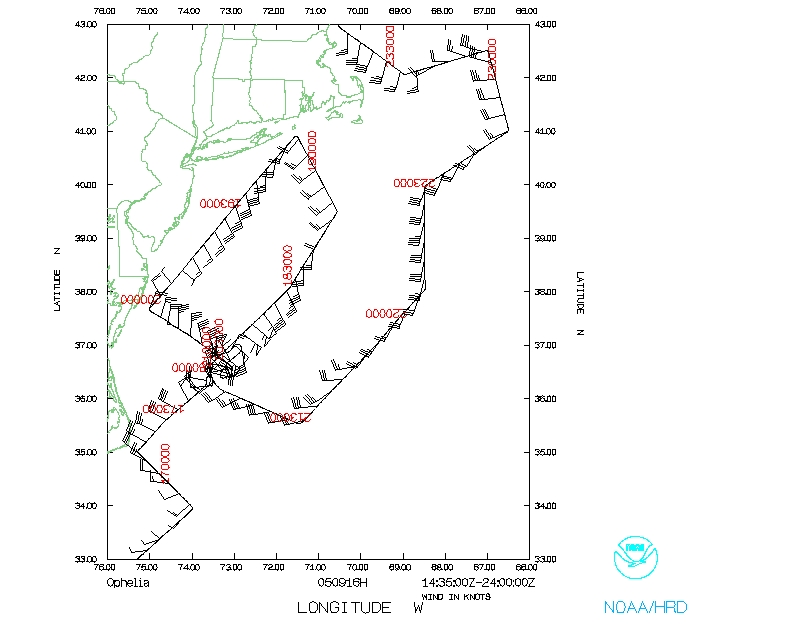Mission Summary
20050916H1 Aircraft 42RF
Extratropical Transition Experiment
Ophelia flight 2005
Aircraft Crew (42RF)
| Phil Kennedy | Pilot |
| Tom Strong | Pilot |
| Tom Shepherd | Flight Director |
| Greg Bast | Flight Engineer |
| Tim Gallagher | Navigator |
| Sean McMillan | Electrical Technician |
| Beth Kerr | Electrical Technician |
| Bill Olney | Electrical Technician |
Scientific Crew (42RF)
| Sim Aberson | LPS |
| Krystal Valde | Dropsonde |
| Paul Leighton | Radar Workstation |
Mission Plan :
Extratropical transition experiment. Depart MacDill 10:00 AM EDT,
perform a Figure-4 in the transitioning storm, then synoptic drops to the
northeast, landing at Portsmouth International Airport, NH at 6:00 PM EDT.
Drop at center, radius of maximum winds, and endpoints of the Figure-4.
AXBTs released along forecast flight track.
Mission Summary :
Took off from MacDill at 1434 UTC. Reached the IP at 1650,
and began the Figure-4. Ophelia had a very tight circulation with radius of
maximum winds about 3 km. Convective structure was asymmetric, with nearly all
convection to the north and northeast of the center. However, convection was
very strong with echoes on LF > 50 dBz. The system looked more like a
supercell than a tropical cyclone at the time.
Finding the center was difficult on both passes because of the tiny size and
because of moderate turbulence in clear air approaching the center. Turbulence
disappeared in cloud, contrary to usual practice. Both passes were completed
after much hunting and pecking, but this might be why the radar analysis
software did not work during this mission.
SSTs from BTs along the flight track ranged from 26.2°C to 23.8°C
to 25.2°C to only 16°C just southwest of Yarmouth, NS. Only one
dropwindsonde failed to have a launch detect.
A warm core remained in the system as it continued to traverse the warm waters
of the Gulf Stream, but cool waters ahead meant that transition would commmence
soon. The rain shield to the northeast was barely evident on this day, and the
signature looked symmetric on satellite.
PDF plots of drop data
Problems :
Problems were encountered using the x-chat system which repeatedly
went down. Despite entering comments, nobody else saw the majority. Also, as
stated above, the radar analysis software did not work on the two passes. One
dropwindsonde needed to be FTPed to the workstation from the AVAPS station.
Mission Data :
Ten second listing
Raw data from companion Aerosonde flight
Dropsonde plots :
500 mb plot of drops
700 mb plot of drops
850 mb plot of drops
925 mb plot of drops
1000 mb plot of drops
sfc mb plot of drops
Page last updated September 27, 2005
Return to Mission page.


